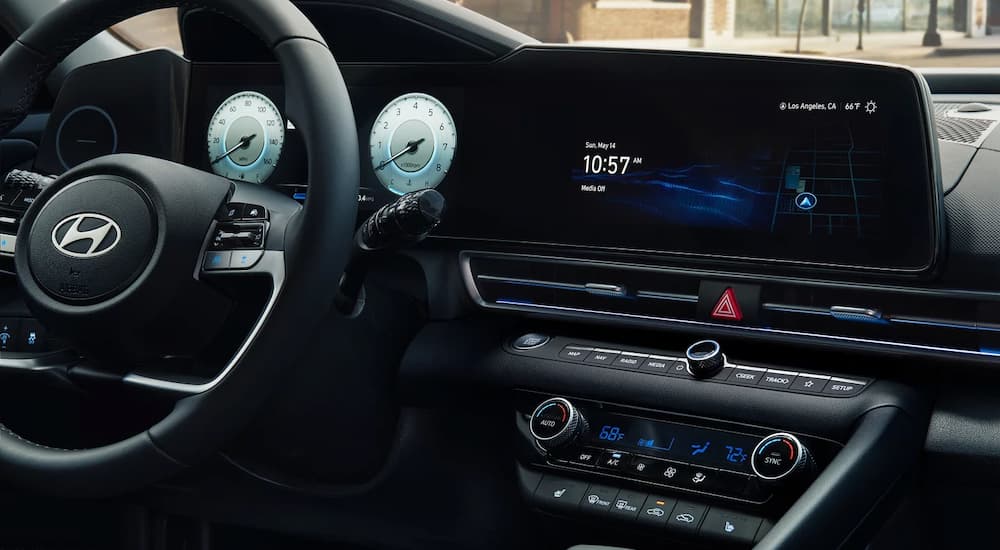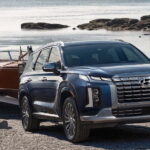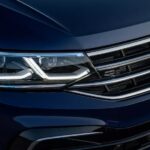If you’re looking for a stylish, affordable, and fuel-efficient option at your local Hyundai dealer, the Elantra is a solid choice. This compact sedan is popular among commuters, small families, and students who want a solid array of tech features and a smooth ride without shelling out an arm and a leg for a less practical option.
While settling on the Elantra may be fairly simple for some, choosing which variant is a bit more complicated. This model comes in a variety of trims, each with their own balance between starting price and included features. Those features range from the cabin tech to the powertrain under the hood. Today, we’re going to walk you through the basics to help you figure out which Elantra is the best fit for you.

Powertrain Options
There are four powertrain options available on the Elantra. The base option, which comes standard on the most affordable trim levels, is a 2.0L I-4 engine that produces 147 hp and 132 lb-ft of torque and boasts a solid fuel economy rating of 36 MPG combined. This option won’t give you much in the way of on-road thrills, but it’s a practical choice that powers the car just fine and won’t send you running to the gas station too often. If you can’t afford to upgrade beyond this, there’s no need to worry.
If you’re looking for a more efficient option, for environmental or economic reasons, the hybrid powertrain is definitely worth considering. It pairs a 1.6L I-4 engine with electric power, delivering a little less horsepower at 139 hp but way more torque at 195 lb-ft, so you’ll have a little more oomph in certain driving situations. Most importantly, you’ll get 50 MPG combined on the SEL Sport or Limited trims and 54 MPG combined on the Blue trim, giving you a fuel economy well above average to avoid pain at the pump.
Those who prioritize performance over efficiency will want to look to the N Line trim, which is powered by a 1.6L turbocharged I-4 engine with 201 hp and 195 lb-ft of torque. Those who demand only the best will want the high-powered N trim, boasting a 2.0L turbo I-4 engine that outputs 276 hp and 289 lb-ft of torque for fast acceleration. Of all the Elantra variants, only the Elantra N is available with a manual transmission, which enthusiasts may prefer. Both of these sporty options come at the expense of fuel economy, though, bringing the rating down to 31 MPG combined for the N Line and as little as 23 MPG combined for the N, so if you don’t consider yourself a driving enthusiast, you’re probably better off avoiding these altogether.
Trim Overview
On Hyundai’s website, you won’t find the full Elantra lineup on one page. It’s broken up into three different versions, each with its own options. The one that’s simply for the “Elantra” features only non-hybrid options. This model has five trim levels. The SE is the most affordable and basic. The SEL Sport adds some sporty accents, while the SEL Convenience has a well-appointed interior with extra creature comforts. The Limited goes all-out on advanced tech and high-end interior features. Finally, the N Line has performance features like a more powerful engine, a multi-link independent rear suspension, and paddle shifters. The higher up the list of trims you climb, the higher the starting price. The Elantra N is the priciest non-hybrid option. It gets its own unique page, since it targets an enthusiast demographic rather than the everyday driver mentality of the rest of the trims. If you’re not seeking out a “performance car” specifically, you can simply set this one aside.
The Elantra Hybrid has a simpler lineup with three trims. Blue is the most affordable of these, and also the most fuel-efficient, which is a win-win for buyers on a budget. While Blue has some traits in common with the Elantra SE, it has a different name because the two don’t fully line up in terms of features. For instance, Blue comes standard with Proximity Key entry with push button start, while SE does not. The SEL Sport and Limited line up a bit more neatly with their non-hybrid counterparts, but if you want a specific feature, like heated side mirrors or ventilated front seats, you should definitely double-check the particulars before you buy. Do not assume everything will be the same between the non-hybrid and the hybrid versions. Because they have a more advanced powertrain, the hybrid models have more expensive starting prices across the board, with the hybrid Blue costing just a bit less than the non-hybrid SEL Convenience, the hybrid SEL Sport costing more than the non-hybrid Limited, and the hybrid Limited slotting in between the non-hybrid N Line and N.

Technology
The Elantra comes standard with a fair amount of tech. Even on the entry-level SE trim, you’ll find USB ports for both the front and back rows, wireless Apple CarPlay and Android Auto, steering-wheel mounted controls, and a hands-free phone system with voice recognition. However, there are definitely perks to upgrading to a higher trim if you want the best tech setup possible. While the entry-level trim has an eight-inch touchscreen and a 4.2-inch gauge cluster, higher trims get a sleeker display that places a 10.25-inch touchscreen and a 10.25-inch gauge cluster side-by-side for a sleek look that makes it easy to quickly glance at information before turning your attention back to the road.
You can also upgrade to wireless device charging to clear up cord clutter, dual-zone automatic climate control for comfort in any weather, and a hands-free smart trunk release for easy access to cargo. Features like customizable ambient interior lighting aren’t as useful, but have a certain amount of cool factor. Of course, there’s an available audio upgrade: a Bose premium sound system with eight speakers, including a subwoofer.
Comfort
Perhaps the most desirable upgrades are those that make the cabin more comfortable. Some of the Elantra’s higher-end trims replace the manually adjustable driver seat with a power version with lumbar support and have all-weather comforts like heated and ventilated front seats. If more natural lighting makes you feel more at home behind the wheel, you can opt for a trim with a sunroof.
Safety
The vast majority of the Elantra’s safety features are standard across all trims. Driver assistance like forward collision avoidance with pedestrian detection, lane keep assist, high beam assist, and brake assist are standard fare, as you might expect for most vehicles these days. Hyundai takes its offerings a step beyond the norm by including features like blind-spot warning, driver attention warning, rear cross-traffic assist, and safe exit warning on the SE, giving entry-level models a good array of protection from all directions. The few safety features requiring a trim upgrade include a more advanced forward collision-avoidance assistance system with cyclist and junction-turning detection and adaptive cruise control. The latter can be especially convenient for those who often drive on the freeway, so you might want to consider upgrading if that’s the case for you.
Picking the Right Elantra Can Make a Big Difference
It’s fair to say that the Hyundai Elantra goes out of its way to make even its affordable base trims attractive to drivers. With an impressive lineup of safety features, a good infotainment setup, and an efficient base engine, the SE is a perfectly serviceable model that’s a great choice for those on a budget. However, that doesn’t mean it’s right for everyone. If you drive a lot and want to make sure you get a well-appointed cabin, a highly efficient hybrid powertrain, or more dynamic performance, it’s worth considering the other options in the Elantra lineup. Choosing the right trim can be the difference between merely using your car to get from place to place and truly getting the most out of your time on the road.



